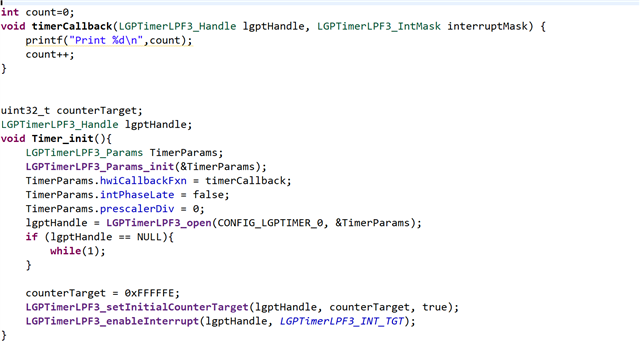主题中讨论的其他器件:ENERGYTRACE
如何在 TI 配置计时器。 请为我提供相同的示例代码。 我曾尝试使用此代码、但不起作用。

此外 、我还在 CCS 中使用了 Energytrace 选项。 它显示4 - 5天电池寿命,我不知道它是否显示正确或错误。 请确认。
This thread has been locked.
If you have a related question, please click the "Ask a related question" button in the top right corner. The newly created question will be automatically linked to this question.
如何在 TI 配置计时器。 请为我提供相同的示例代码。 我曾尝试使用此代码、但不起作用。

此外 、我还在 CCS 中使用了 Energytrace 选项。 它显示4 - 5天电池寿命,我不知道它是否显示正确或错误。 请确认。
大家好、 Ankit Jaiswal、
在查看您的代码片段时、您似乎没有包含"LGPTimerLPF3_start"、它不会启动计时器、这将解释计时器为何不工作。 由于该器件从不进入低功耗模式、因此功耗相对较高(对于以下代码、I 测量结果为~1.5天、因为 CPU 始终处于运行状态+ GPIO、如果我卸下 GPIO 护盖以将其断开、则为6天)。
下面是我根据 TI 驱动程序库改编的示例:
int count = 0;
int val = 0;
LGPTimerLPF3_Handle hTimer;
void timerCallback(LGPTimerLPF3_Handle lgptHandle, LGPTimerLPF3_IntMask interruptMask) {
count++;
val = count;
}
/*
* ======== mainThread ========
*/
void *mainThread(void *arg0)
{
/* 1 second delay */
uint32_t time = 1;
/* Call driver init functions */
GPIO_init();
/* Configure the LED pin */
GPIO_setConfig(CONFIG_GPIO_LED_0, GPIO_CFG_OUT_STD | GPIO_CFG_OUT_LOW);
GPIO_setConfig(CONFIG_GPIO_LED_1, GPIO_CFG_OUT_STD | GPIO_CFG_OUT_LOW);
uint32_t counterTarget;
hTimer = NULL;
LGPTimerLPF3_Params params;
LGPTimerLPF3_Params_init(¶ms);
params.hwiCallbackFxn = timerCallback;
hTimer = LGPTimerLPF3_open(CONFIG_LGPTIMER_0, ¶ms);
if(hTimer == NULL) {
//Log_error0("Failed to open LGPTimer");
//Task_exit();
}
counterTarget = 48000; // 1 ms with a system clock of 48 MHz
LGPTimerLPF3_setInitialCounterTarget(hTimer, counterTarget, true);
LGPTimerLPF3_enableInterrupt(hTimer, LGPTimerLPF3_INT_TGT);
LGPTimerLPF3_start(hTimer, LGPTimerLPF3_CTL_MODE_UP_PER);
sleep(time);
while (1)
{
sleep(time);
GPIO_toggle(CONFIG_GPIO_LED_0);
}
}
谢谢。
A·F
大家好、 Ankit Jaiswal、
为了帮助减少功耗、我先后使用了 LGPTimerLPF3_STOP 和 LGPTimerLPF3_Close 来停止/关闭定时器;有关如何正确停止定时器的详细信息包含在 LGPTimerLPFE.h 文件中。 计时器关闭后、功耗会 大幅降低、而我测得的数据是4年(使用 CCS EnergyTrace 工具并关闭 GPIO)、而不是6天的电池寿命。 为了实现 这一点、我使用了以下代码片段(empty.c 项目的修改版本):
void *mainThread(void *arg0)
{
/* 1 second delay */
uint32_t time = 1;
/* Call driver init functions */
GPIO_init();
/* Configure the LED pin */
GPIO_setConfig(CONFIG_GPIO_LED_0, GPIO_CFG_OUT_STD | GPIO_CFG_OUT_LOW);
GPIO_setConfig(CONFIG_GPIO_LED_1, GPIO_CFG_OUT_STD | GPIO_CFG_OUT_LOW);
uint32_t counterTarget;
hTimer = NULL;
LGPTimerLPF3_Params params;
LGPTimerLPF3_Params_init(¶ms);
params.hwiCallbackFxn = timerCallback;
hTimer = LGPTimerLPF3_open(CONFIG_LGPTIMER_0, ¶ms);
if(hTimer == NULL) {
//Log_error0("Failed to open LGPTimer");
//Task_exit();
}
counterTarget = 48000; // 1 ms with a system clock of 48 MHz
LGPTimerLPF3_setInitialCounterTarget(hTimer, counterTarget, true);
LGPTimerLPF3_enableInterrupt(hTimer, LGPTimerLPF3_INT_TGT);
LGPTimerLPF3_start(hTimer, LGPTimerLPF3_CTL_MODE_UP_PER); //LGPTimerLPF3_CTL_MODE_UP_ONCE
sleep(time);
LGPTimerLPF3_stop(hTimer);
LGPTimerLPF3_close(hTimer);
while (1)
{
sleep(time);
GPIO_toggle(CONFIG_GPIO_LED_0);
}
}
谢谢。
A·F